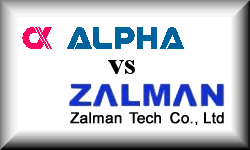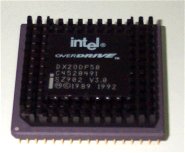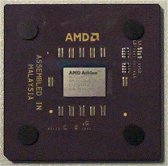Alpha PAL6035 vs Zalman CNPS3100-Gold (1/4)
Posted by Wesley on
Heat in computers have always posed problems to a certain degree. Preliminary electronic computers using vacuum tubes such as ENIAC could not run for more than 30 minutes easily due to burnouts of overheating tubes. Mainframe computers usually operated in air-conditioned rooms. Some modern super-computers operate suspended in a case filled with inert liquid coolant.
However, personal computers traditionally had few heat-related problems because the components never ran fast or hot compared to the state-of-the-art technologies that existed at the time. Few, if any, systems with heatsinks on a 286 or 386 chips appeared, for the chips were only warm to the touch during normal operation.
 This trend started to change at around the propagation of 486 chips. They were already becoming too hot to touch, and faster versions of 486 started to have heatsink attached on the ceramic package. The Pentium Overdrive processor, shown on the left and plugged into a 486 system, shows such examples of early heatsink coupled CPUs. First Pentium CPUs, the 60MHz and 66MHz versions, were notorious for excessive heat dissipation and was one of the first personal computer CPUs requiring active cooling by motorized fan. Since then, HeatSink-Fan combo(HSF) became standard attachment to CPU.
This trend started to change at around the propagation of 486 chips. They were already becoming too hot to touch, and faster versions of 486 started to have heatsink attached on the ceramic package. The Pentium Overdrive processor, shown on the left and plugged into a 486 system, shows such examples of early heatsink coupled CPUs. First Pentium CPUs, the 60MHz and 66MHz versions, were notorious for excessive heat dissipation and was one of the first personal computer CPUs requiring active cooling by motorized fan. Since then, HeatSink-Fan combo(HSF) became standard attachment to CPU. The problem did not end there, though. Personal computer CPU development was accelerating day by day and introduction of ever-so-powerful CPUs were frequent. Processing power-wise, top-of-the-line CPUs today are comparable to top 100 supercomputers of only 4 to 5 years ago. In consequence, CPU's heat dissipation rate gradually increased. Smaller manufacturing process does help CPU produce less heat, but this does not help much in reducing the heat dissipation of the most powerful processor on the market. This is because the operating frequency is increasing at a faster rate. One of the hottest(literally and figuratively) chip of today, AMD's 'Thunderbird' Athlon can run without any discernible heat if you run it at 66MHz like the aforementioned early Pentiums. But you don't run Athlon at 66MHz in reality; you run it at up to 1.2GHz, almost 20 times of the Pentium speed.
The problem did not end there, though. Personal computer CPU development was accelerating day by day and introduction of ever-so-powerful CPUs were frequent. Processing power-wise, top-of-the-line CPUs today are comparable to top 100 supercomputers of only 4 to 5 years ago. In consequence, CPU's heat dissipation rate gradually increased. Smaller manufacturing process does help CPU produce less heat, but this does not help much in reducing the heat dissipation of the most powerful processor on the market. This is because the operating frequency is increasing at a faster rate. One of the hottest(literally and figuratively) chip of today, AMD's 'Thunderbird' Athlon can run without any discernible heat if you run it at 66MHz like the aforementioned early Pentiums. But you don't run Athlon at 66MHz in reality; you run it at up to 1.2GHz, almost 20 times of the Pentium speed.Where does all this lead to? Need for better and better HSFs. Some overclockers go so far as to install thermoelectric modules(a.k.a. Peltiers) or water cooling on the CPU, and a few extremists even attempts to dip the system in liquid nitrogen to obtain ultimate cooling. This cannot be the solution for everyone, though, because installation of such things without good background knowledge and caution can ruin the whole system. Companies like VapoChill offers powerful cooling solution by effectively bringing in a small refrigerator into the computer case. This method may be safer, but this is out of reach for many, because the cost is too high.
And so, in today's article, I have compared two heatsinks deemed to be among the most powerful HSF solutions out there.